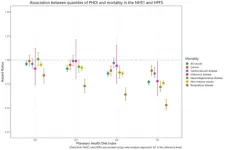(Press-News.org) Researchers report that blood levels of the omega-3 fatty acid docosahexaenoic acid (DHA) were inversely correlated with hearing difficulty in a new population-based cross-sectional study. Middle-aged and older adults with higher DHA levels were 8-20% less likely to report age-related hearing issues than those with lower DHA levels.
“Higher DHA levels have previously been found to be associated with a lower risk of heart disease, cognitive impairment, and death. Our study extends these findings to suggest a role for DHA in maintaining auditory function and helping reduce the risk of age-related hearing loss,” said Michael I. McBurney, PhD, a senior scientist with the Fatty Acid Research Institute and an adjunct professor in the Department of Human Health & Nutritional Sciences at the University of Guelph and the Friedman School of Nutrition Science and Policy at Tufts University.
McBurney, a Fellow of the American Society for Nutrition and the Canadian Nutrition Society, will present the findings at NUTRITION 2023, the flagship annual meeting of the American Society for Nutrition held July 22–25 in Boston.
Using data from the UK Biobank, the researchers analyzed self-reported hearing status and blood DHA levels of over 100,000 people 40-69 years of age in the United Kingdom. After accounting for potential confounding variables, the results showed that people in the highest quintile (one-fifth of participants) of blood DHA levels were 16% less likely to answer yes to the question ‘do you have difficulty hearing’ compared with those in the lowest quintile of DHA levels. Similarly, those in the highest quintile for DHA levels were 11% less likely to answer yes to the question ‘do you have difficulty following conversations when there is background noise’ compared with people in the lowest quintile for DHA levels.
While the results show a significant association between DHA levels and hearing, McBurney cautioned that a cross-sectional population study does not provide enough evidence to definitively conclude that DHA maintains auditory function or that inadequate DHA levels contribute to hearing loss. However, the findings add to a mounting body of evidence of the importance of omega-3 fatty acids, including DHA in particular, to maintain health and help protect against aging-related declines in a variety of body functions.
Omega-3s may help to protect the health of cells in the inner ear or mitigate inflammatory responses to loud noises, chemicals, or infections. Previous studies conducted in older adults and in animals have similarly suggested that higher omega-3 levels are inversely related to and may protect against age-related hearing loss.
Our bodies have a limited ability to produce DHA, so the amount of DHA found in our blood and tissues largely depends on our omega-3 intake. DHA levels can be increased by regularly consuming seafood or by taking dietary supplements.
“There is strong evidence that higher blood levels of omega-3 fatty acids are beneficial,” said McBurney. “Fatty fish and omega-3 supplements are both good dietary sources. If choosing to use a dietary supplement, compare products by reading the Supplement Facts panel for eicosapentaenoic acid (EPA)+DHA content.”
It is estimated that around 20% of people—over 1.5 billion people worldwide—live with hearing loss, and this number is expected to rise as the population ages in the coming decades. Hearing loss can range from mild to profound; it affects communication and social interactions, educational and job opportunities, and many other aspects of daily life.
Environmental factors as well as genetic proclivities and medicines contribute to hearing loss. Proven ways to reduce the risk of hearing loss include protecting the ears from loud noises by using protective equipment and getting appropriate medical care for infections.
McBurney will present this research at 8:09 a.m. EDT on Monday, July 24, during the Nutrition-related Factors in Aging and Chronic Disease Poster Theater Flash Session in the Sheraton Boston, Fairfax (abstract; presentation details).
Please note that abstracts presented at NUTRITION 2023 were evaluated and selected by a committee of experts but have not generally undergone the same peer review process required for publication in a scientific journal. As such, the findings presented should be considered preliminary until a peer-reviewed publication is available.
About NUTRITION 2023
NUTRITION 2023 is the flagship meeting of the American Society for Nutrition and the premier educational event for nutritional professionals around the globe. NUTRITION brings together lab scientists, practicing clinicians, population health researchers, and community intervention investigators to identify solutions to today’s greatest nutrition challenges. Our audience also includes rising leaders in the field – undergraduate, graduate, and medical students. NUTRITION 2023 will be held July 22-25, 2023 in Boston. https://nutrition.org/N23 #Nutrition2023
About the American Society for Nutrition (ASN)
ASN is the preeminent professional organization for nutrition research scientists and clinicians around the world. Founded in 1928, the society brings together the top nutrition researchers, medical practitioners, policy makers and industry leaders to advance our knowledge and application of nutrition. ASN publishes four peer-reviewed journals and provides education and professional development opportunities to advance nutrition research, practice, and education. Since 2018, the American Society of Nutrition has presented NUTRITION, the leading global annual meeting for nutrition professionals. http://www.nutrition.org
Find more news briefs from NUTRITION 2023 at: https://www.eurekalert.org/newsroom/nutrition2023.
###
END
Losing weight is often a goal for people with type 2 diabetes, which is strongly associated with being overweight or obese. However, it hasn’t been clear what dieting strategy works best for people with this metabolic disorder.
A new randomized controlled study of people with type 2 diabetes showed that study participants who restricted eating to between noon and 8 p.m. daily lost more weight than those who reduced their overall calorie intake by counting calories. Both dieting strategies produced similar improvements in blood sugar levels.
“Many people find counting calories very hard to stick to in the long term, ...
Caecilians are an elusive type of amphibian that primarily live underground and look like a cross between a worm and a snake. One of the few things that is known about caecilians is their unique method for feeding their young. Mothers produce a special layer of fatty skin tissue, which juvenile caecilians tear off with baby teeth that evolved specifically for that purpose.
A new study shows that skin-feeding does more than provide nutrients for young caecilians. It also helps the mother pass microbes from her skin and gut down to her young, inoculating them to jump-start a healthy ...
A technique that uses imaging technology as a guide can make radiation therapy safer for patients with prostate cancer by helping clinicians accurately aim radiation beams at the prostate while avoiding nearby tissue in the bladder, urethra, and rectum. That is the finding of a thorough analysis of all published clinical trials of the technique, called magnetic resonance–guided daily adaptive stereotactic body radiotherapy (MRg-A-SBRT). The analysis is published by Wiley online in CANCER, a peer-reviewed journal of the American Cancer Society.
By providing detailed images, MRg-A-SBRT can be used to adjust a patient’s radiation plan every ...
Children and adolescents living in food-insecure households had a 55% higher frequency of physician visits for mental health reasons than those with adequate food supplies, according to new research published in CMAJ (Canadian Medical Association Journal) https://www.cmaj.ca/lookup/doi/10.1503/cmaj.230332.
In 2021, almost 6 million people Canada, including 1.4 million children and adolescents younger than 18 years faced food insecurity; that is, inadequate food intake because of financial problems.
The study looked at population health survey data from the Canadian Community Health Survey on ...
Teleost fish encompass a diverse group, among which seahorses display a unique morphology. The characteristic spines and brood pouch seen in seahorses feature distinctive epithelial cells—called flame cone cells—covered by a mucous cap. However, these cells are not found in the barbed pipefish Urocampus nanus or the seaweed pipefish Syngnathus schlegeli, close relatives of the seahorse, belonging to the Syngnathidae lineage. While research has hypothesized the function of the flame cone cells, their evolutionary origins have remained a mystery.
Now, a team of scientists led by Assoc. Prof. Mari Kawaguchi and Prof. Shigeki Yasumasu from the Department of Materials ...
According to an analysis of the UK’s cosmetic injectables industry by UCL researchers, 68% of cosmetic practitioners who are administering injections such as Botox are not qualified medical doctors.
The study, published in the Journal of Plastic, Reconstructive & Aesthetic Surgery, is the first survey of who is providing cosmetic injectable services, such as Botulinum Toxin (Botox) and Dermal Fillers, in the UK. Currently, little is known about the background qualifications, training and experience levels of those who are administering treatments.
To fill this ...
3D printing of complex objects typically takes a long time due to the printing process necessarily laying down a large number of 2D layers to build up the object. The process usually wastes a lot of material required to support the unfinished object. Some novel ways to make flat materials self-fold into 3D shapes exist, but have shortcomings. For the first time, researchers combined 2D printing, origami, and chemistry to create a method of rapid 3D object fabrication without creating any waste material. These shapes self-fold in seconds.
For some time, 3D printing has been used to prototype ...
A diet originally designed to help ward off cognitive decline in adults might also help improve attention in pre-adolescents, according to a new study. The findings could help inform future dietary interventions aimed at improving cognition in children.
The new study examined two diets: the Healthy Eating Index – 2015 (HEI-2015), which is based on the Dietary Guidelines for Americans, and the Mediterranean-DASH Intervention for Neurodegenerative Delay (MIND) diet, which combines the Mediterranean diet with the heart-healthy Dietary Approaches to Stop Hypertension ...
Eating more planet-friendly foods could help you live a longer, healthier life, according to new research. Researchers found that people who followed a more environmentally sustainable diet were 25% less likely to die during a follow-up period of over 30 years compared to those with a less sustainable diet.
The study builds upon prior research that identified foods that are a win-win for both health and the environment—such as whole grains, fruit, non-starchy vegetables, nuts, and unsaturated oils—as well as foods that could be harmful to the environment and human health, like eggs ...
A study of over 10,000 children in rural Pennsylvania revealed that a large proportion of children were fed foods that are high in sugar and salt in their first years of life.
Over half (53%) of the children in the study received high-sodium meats such as hot dogs, 37% received salty snacks such as potato chips, and one-third (34%) received cakes, cookies, or pudding before age 2. In addition, over one-quarter (27%) of babies received juice before their first birthday.
“Given ...




